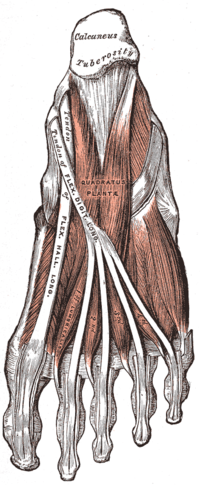
Photo from wikipedia
The quadratus plantae (QP) is considered as a part of the plantar intrinsic foot muscles. This muscle has two lateral and medial heads of origin, both of which arise from… Click to show full abstract
The quadratus plantae (QP) is considered as a part of the plantar intrinsic foot muscles. This muscle has two lateral and medial heads of origin, both of which arise from the plantar surface of calcaneus, and insert into the tendon of flexor digitorum longus (FDL). Various functions have been attributed to the QP muscle, which includes assisting the plantar flexion of the lateral four toes, straightening the oblique pull of FDL and etc. Several anatomical variations of the QP muscle have been reported in the literature. During a routine dissection in the department of anatomy at Kerman University of Medical Sciences, a variant plantar muscle was observed in a 40-year-old male cadaver. In the present case, we report a rare variation associated with the insertion pattern of this muscle, which is reported for the first time in Iran. The tendinous end of the QP muscle was divided into 3 tendons and were then inserted to the inferior surface of 2nd, 3rd and 4th tendons of FDL. Also, a slim tendinous interconnection was also observed between the QP and flexor hallucis longus (FHL). The lack of connection between the FDL and FHL tendons was the other rare variation of this case. Exact knowledge of the possible variations of the QP muscle is of utmost importance to foot surgeons, clinicians and also anatomists.
Journal Title: Folia morphologica
Year Published: 2022
Link to full text (if available)
Share on Social Media: Sign Up to like & get
recommendations!